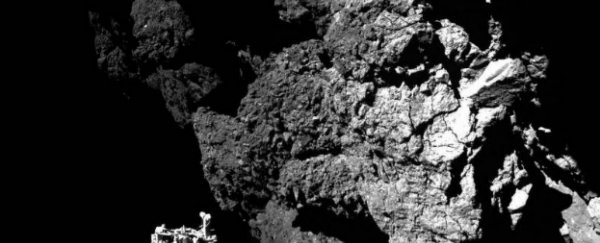The European Space Agency (ESA) Philae only had a short amount of time to do science on Comet 67P/C-G before its batteries went flat due to a lack of sunlight - but within 60 hours the little lander managed to perform some important experiments and send a whole lot of data back to scientists on Earth.
The ESA confirmed to The Wall Street Journal exclusively on Monday that in this data was evidence that Philae had sniffed organic molecules in the comet's atmosphere. Organic compounds are those that contain carbon atoms, and they also happen to be the basis of life on planet Earth.
This could be a very exciting discovery, as it will help scientists understand more about the make-up of a comet, and potentially where life on Earth originated.
Scientists are now investigating further what type of molecules these are. The research "will help us to understand whether organic molecules were brought by comets to the early earth," Stephan Ulamec, the Philae landing manager, told The Wall Street Journal.
The theory that life on Earth was brought by comets or meteors is known as panspermia, and it opens up exciting possibilities for life in the rest of the Universe.
However, before we get too excited, it's also important to remember that we still have no idea what type of molecules we've found on Comet 67P/C-G - yes, they could be the kind that are building blocks for life, but they could also be simple things such as methane and methanol.
In fact, Rosetta had already detected traces of methane and methanol, two non-life-building organic gasses in the atmosphere of the comet, so it's possible Philae has just found further evidence of these. Scientists also need to work out whether the molecules on the comet are left- or right-handed.
As Rachel Feltman writes for The Washington Post:
"So while we can still hope to learn a tonne about comets, the origin of life and the nature of the solar system from the interpretation of Rosetta's data, don't let hype make you jump the gun. We should be excited that Philae's instruments worked well enough to sniff these molecules out, but that's the only takeaway for now."
Perhaps the most exciting part about this whole discovery is the fact that it's proof that Philae's equipment works well enough to do some serious science. Philae powered down over the weekend after it only got 1.5 hours of light a day instead of the expected seven. But although the little lander has fallen silent for now, there's a chance that it could get more sunlight as the comet moves closer to the Sun and its solar-powered batteries could turn it back on at least for a few more hours.
And who knows what else it could teach us in that next little window of life.
"Prior to falling silent, the lander was able to transmit all science data gathered during the First Science Sequence," Ulamec told The Wall Street Journal. "This machine performed magnificently under tough conditions, and we can be fully proud of the incredible scientific success Philae has delivered."
